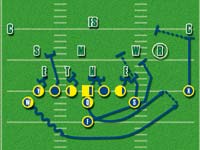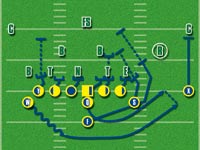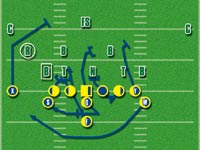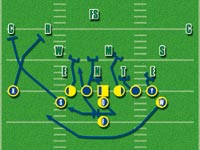AMERICAN FOOTBALL MONTHLY THE #1 RESOURCE FOR FOOTBALL COACHES
Article CategoriesAFM Magazine
|
Solid GroundWhy does Air Force still run the option?by: Dean Campbell Running Backs Coach, Air Force Academy © More from this issue
Most conventional offenses spend a lot of time working against nickel and dime packages, and being able to pick up all the different blitzes they will see from all these different packages. We normally see the same defense every snap and very seldom, if ever, do we see any blitzes. Most defenses just do not like to blitz vs. option teams. Because we are a quick hitting offense, we do not have to dominate the line of scrimmage. We only need a tie for a short time at the point of attack. Double teams and combo blocks on the play side help us to get some movement when we need it. We have always felt that getting the ball in space on the perimeter is very important. Our double and triple option schemes allow us to do that. We can get a lead blocker in front of our ball carrier, or maybe give our backs a chance to get a one-on-one against a safety or corner with a chance for a big play. Every year most of our long runs come when we get people sealed off inside and we get a key block or two on the edge. Being able to read the defense on the option gives us the ability to neutralize some really good players. When we read the triple option, we don’t have to block two of the best players on the defense, so we don’t have to get a hat on everybody and try to overpower people. We want to teach a physical mentality to all areas of our football team. By running the ball in Spring Training, it gives our defense a chance to be physical also. We believe if we are going to be good on defense, we are going to have to stop the run during the season. Our offensive linemen like the fact that they are always in a three-point stance and coming off attacking people. They take lot of pride when we are able to rush for 300 and 40 yards in a game. We are different from a lot of people in the fact that we are tickled to death to make four yards on any given play. If we can avoid a big negative play, we can stay on schedule with four yards and keep moving the chains. This season we averaged about six or seven negative yardage plays a game and we only gave up five sacks in 13 games, so we were able to stay out of a lot of third and long situations. Any defensive coach will tell you that ball control is the best defense you have, and we will try to run as many plays and eat up as much of the clock as we can, and keep our defense off the field. Our offense is the same from goal line to goal line, so we don’t have to limit things that we do in the Red Zone. We spend a lot of time emphasizing Red Zone efficiency in practice every week. We feel we really have a big advantage in four-down territory because our offense is what a lot of other teams try to emulate in short yardage situations. So what other teams work in a special period for short yardage, we are running as our every-down offense. Where a lot of teams have a fear of going for it on fourth and short because they are not good at running the ball and being physical, we will go for it quite a bit and not just in four-down territory. The biggest criticism of any option offense is that you can’t pass the ball effectively. We don’t do a lot of different things in the passing game. Most of our throws come off of play-action off our option game. We have a pass off most of our options and we are trying to either slow down a defender or take advantage of a fast-pursuing defender. We feel play-action passes are the toughest to defend, and it puts a lot of pressure on the secondary. I’m sure we don’t strike a lot of fear in many defensive coordinators with our passing game, but we did have a lot of big plays this year and we led the nation in yards per completion (17.5). We have a number of different options that we run. Whether we run a “zone” or a “veer” option is normally predicated on whether it is a seven-man front (4-3, 6-1, 50), or an eight-man front (Eagle shade, 6-2, wide G). The way we teach the quarterback to identify defenses is simply to have him look for a zero technique on the center or a middle linebacker. If he gets one of those looks, he knows it is a seven-man front. If he gets anything else, he knows it is an eight-man front. Let’s take a look at a couple of our favorite options. We will look at one of our “zone” double options vs. a seven-man front and a “veer” triple option vs. an eight-man front.
QB - First step at 6 o’clock, pivot on second step and attack pitch key FB - Block PSLB to FS. You have the stack (inside-outside) against a 4-3 HB - Combo block with OT to MLB HB - Run 34-35 (pitch path) X - Read crack Y - Backside - stay, cut-off, block deep middle 1/3 ST - Hinge - Scoop - Switch SG - Scoop - Base - Switch C - Scoop - Base - Wild Card - Wild Red QG - Base - Wide Red QT - Base reach the EOL - slotback will give you help QB - Read first defender on LOS from B-Gap to outside. Attack downhill and option QB responsibility. Turn up field if slow play. On ARC, read space. FB - Aim at outside hip of guard and mesh with QB for give or disconnect. Read guard’s block if covered. HB - “5” - Inside 5 linebacker Outside - ARC primary ARC - Inside ARC primary Switch - Inside ARC path and force corner Block Call - “5” linebacker - Best release - Cheat align HB - Run pitch path X - Read crack On Switch, crack first defender inside of you. On Swap, block FS Y - Inside - Block “5” linebacker Block Call - Base Backside - Inside release block deep middle 1/3 PST - Veer blocking - Gold vs. 3 tech PSG - Veer blocking - Gold vs. 3 tech, Red vs. 1 tech C - Scoop or over & up to PSLB or BSLB - Red vs. 1 tech BSG - Scoop - Base - Switch BST - Hinge - Switch In the movie Remember the Titans, the coach of the Titans said that running the option was like taking Novocain – “Just give it enough time and it will work.” That has sort of been our philosophy here at the Academy. Over the last two decades we have had a lot of excellent coaches and a lot of great kids to work with. One of the most satisfying things in coaching is when you can take a group of kids and get them to believe in a system and then see them be successful executing it. Our offensive staff, consisting of Chuck Petersen, Tim Horton, Dick Enga and John Reagan, does a tremendous job each week of preparing our players. We try to have a simple yet thorough game plan, and we try to put our players in a position to be successful. More often than not, the key to the game will be in our ability to make adjustments during the game. Sometimes we get different looks than what we have prepared for, and we must be able to adjust and find something that will work. We always have a sheet that we take to every game that has thoughts on what runs and throws we would want, against any fronts and coverages we could possibly see. We don’t ever want to let our players down by not being able to adjust. Hopefully, this has explained why we do what we do. We get a number of requests from coaches every year for information on our offense. We have recently made a video series that explains our philosophy and shows teaching drills by each of our position coaches. If you are interested in this, you can log on to www.AFMVideos.com, or call American Football Monthly at 561-355-5068, ext. 317.
|
|
| HOME |
MAGAZINE |
SUBSCRIBE | ONLINE COLUMNISTS | COACHING VIDEOS |
Copyright 2024, AmericanFootballMonthly.com
All Rights Reserved








